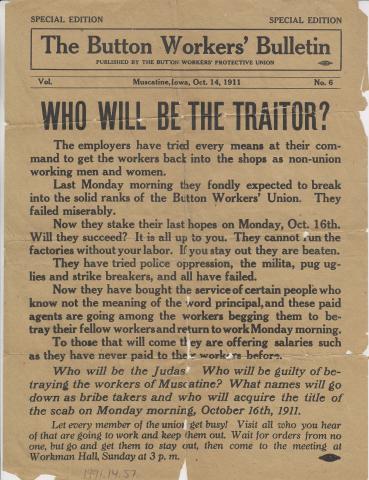This bulletin was created by the Button Workers' Protective Union in October, 1911. The bulletin encourages workers to remain on strike and to not give into pressure from their employers. It also says that those who would return to work were traitors. During July of 1899, disagreements rose over the costs of tools and wages paid to employees. Between 1899 and 1900, nine strikes took place. Eventually the Button Workers' Protective Union was formed in November, 1910. The Union helped organize a large strike in February of 1911 following the closure of 43 sites. They blame overproduction as a reason and organized picket lines outside the factories. A total of 2,300 protesters went on strike and during the following months, the strike gained national attention. Muscatine police along with hired police from Chicago and St. Louis worked with the union to sign a peace agreement in May of 1911. The strike officially ended in in the spring of 1912. Content can be used with the following standards: 2nd grade SS 2.24 Natural Resources, SS-W.H. 9-12.26 Iowans Influence World History and 4th grade SS 4.25 Technological Changes in a lesson on how the natural resources of Iowa led to businesses and the working class struggles of the early 1900s. For any use other than instructional resources, please check with the organization that owns this item regarding copyright restrictions.
2018.010.008 [Bulletin]
Legal Status
Ownership of this resource is held by the Muscatine Art Center and has been provided here for educational purposes only, specifically for use in the Iowa Museum Association's "Teaching Iowa History" project. It may not be downloaded, reproduced or distributed in any format without written permission from the Rights Holder. For information on U.S. and International copyright laws, consult an attorney.

